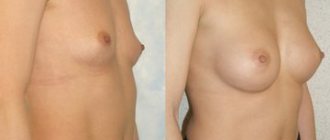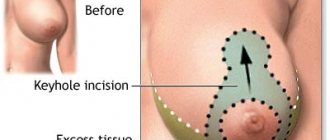General information
The aesthetic role of the female breast is far from the most important. Its main component is the mammary gland, which is designed to provide nutrition to the born child. It consists of lobes, between which connective tissue septa pass. Those, in turn, branch into smaller segments. And the latter are formed by alveoli and efferent ducts, which, uniting, flow into the milky sinuses and ultimately open on the nipple.
The function of glandular tissue depends entirely on hormonal influences. Three biological substances play a key role in the regulatory process: estadiol, progesterone and prolactin. The breasts have receptors for each of the hormones. Estrogens promote the development of the milk ducts and stromal elements, progesterone stimulates the growth and increase in the number of lobules, provokes retention of intercellular fluid, and prolactin helps to increase sensitivity to the first two and is responsible for the production of a specific secretion - human milk. Therefore, during periods when hormonal changes occur in the body, the breasts are subject to the greatest changes.
What hormones are responsible for breast growth?
The formation and growth of female breasts is influenced by a whole range of reasons. But the main role is played by heredity and hormonal levels. Under the influence of hormones, mammary glands form and develop. Especially in adolescence, during puberty.
The pituitary gland is involved in the regulation of hormonal processes and is responsible for the production of prolactin, an important hormone for the functioning of the female mammary glands. This substance affects the process of breast growth and development and milk formation. It takes part in the development of the sebaceous glands and is responsible for the maturation and preservation of the corpus luteum in the ovary.
This part of the brain also produces growth hormone. It affects the weight and height of the body and internal organs. Thanks to it, the mammary glands reach their natural size.
Estrogen and progesterone are produced in the ovaries. The first affects the growth of mammary glands, genitals and other organs:
- liver, kidneys, heart;
- prepares the reproductive system for conception;
- stimulates the formation of secondary sexual characteristics.
Often this hormone is a catalyst in the growth of malignant tumors of the mammary glands.
Progesterone, also called the “pregnancy hormone,” stimulates breast growth during pregnancy. It prepares the mammary glands for breastfeeding and helps maintain pregnancy. It affects the development of the breast ducts to a lesser extent, but accelerates this process. The hormone also reduces the risk of developing a malignant process in the uterus.
Causes and mechanisms
Only a doctor can understand why breasts become a source of discomfort. A specialist with the necessary qualifications and experience will examine the woman and indicate the origin of the problem. In most cases, worries are in vain, because everything is determined by physiological changes. Most often, breast engorgement and tenderness is a normal phenomenon observed during various periods:
- The onset of puberty in girls.
- In the second phase of the menstrual cycle.
- During pregnancy.
- After childbirth.
This effect is primarily due to increased progesterone and growing prolactin. The latter is especially actively produced by the pituitary gland in the last trimester of pregnancy and after the birth of a child. Similar processes are observed during an abortion, but to a much lesser extent. In addition, pain may occur due to the individual characteristics of the body and the increased sensitivity of the nervous system.
In addition to conditions that can be explained from a physiological standpoint, pathological processes, both general and local, become causes of obvious discomfort in the chest. Most often we are talking about endocrine disorders, inflammatory and tumor disorders. Therefore, doctors may suspect:
- Premenstrual syndrome.
- Mastopathy.
- Mastitis.
- Breast cancer.
Hormonal disorders, which often underlie the symptoms that arise, can occur against the background of the influence of unfavorable factors, which include physical fatigue, poor nutrition, emotional stress, infections and intoxications, bad habits, and gynecological diseases. This is something that can disrupt the natural regulatory balance in the female body and cause breast problems. But each case requires individual consideration and differential diagnosis.
When faced with chest discomfort, you should immediately consult a doctor to find out the nature of the changes.
Symptoms
Any condition, including physiological, is manifested by certain symptoms. And when identifying pathology, the clinical picture is extremely important. At the stage of the initial examination, the doctor analyzes and details the complaints, conducts an examination and evaluates objective signs. In a situation with pain and swelling of the chest, you need to determine the main parameters of the symptoms:
- Expressiveness.
- Duration.
- Preferential localization.
- Dependence on external factors, menstrual cycle, etc.
Other signs accompanying the main ones are also revealed. Sometimes they provide equally important information about pathology. This way, an almost complete picture of what is happening is formed and the main reasons why the breasts can become enlarged are determined, causing some concern.
Premenstrual syndrome
For more than half of women, the approach of menstruation will be marked by a complex of vegetative-vascular, emotional and psychosomatic disorders, united under the concept of premenstrual syndrome. Appearing in the second phase of the cycle, they completely disappear with the onset of discharge. One of the manifestations of this condition is considered to be severe breast engorgement, which is accompanied by a feeling of fullness and even pain. But besides this, there will be other signs:
- Irritability and anxiety.
- Headaches, cardialgia.
- Swelling of soft tissues.
- Aches in the joints.
- Numb hands.
- Bloating.
- Nausea and vomiting.
- Diarrhea or constipation.
- Increased heart rate.
The severity and number of symptoms vary within different limits, which allows us to talk about the severity of premenstrual tension and its forms: neuropsychic, edematous, crisis, cephalgic.
Mastopathy
Mastopathy is considered a common condition among women of reproductive age. It is based on benign growth of gland tissue. Therefore, those whose breasts are enlarged and painful should think about this possibility. Symptoms of mastopathy may include:
- The appearance of compactions (nodules).
- Chest pain before the onset of menstruation (mastalgia).
- Clear discharge from the nipples.
Depending on the morphological changes in the gland, three forms of mastopathy are distinguished: diffuse, nodular and mixed. Sometimes pain is provoked by even a light touch to the chest or can radiate to neighboring areas: the armpit or shoulder. And although the process is benign in nature, it can increase the risk of malignant degeneration. Therefore, women should not allow mastopathy to be taken lightly.
Mastopathy is a common disease in modern women. It is benign in nature, but can also become the initial stage of oncology.
Mastitis
If the breast hurts and has increased in volume, then inflammatory diseases – mastitis – cannot be ruled out. They are observed during the development of infection or are provoked by congestion in the gland (lactostasis). The breast turns red and swells, the skin over it is hot to the touch, purulent contents may be discharged from the nipple, and palpation is characterized by severe pain. The woman’s general condition also suffers: malaise appears and the temperature rises. The inflammatory process can acquire an encysted character, i.e., proceed like an abscess. Then your health deteriorates even more.
Breast cancer
The greatest danger among breast problems is a malignant process in the glandular tissue - cancer. The tumor is initially completely asymptomatic and is often detected only during a preventive examination. And among the clinical symptoms that develop later, the following should be alert:
- The appearance of a dense, painless node, fused to the surrounding tissues, the size of which does not depend on the phases of the menstrual cycle.
- Skin changes: redness or marbling, lemon peel, ulcer.
- Retraction of the nipple area.
- Bloody issues.
- Breast deformity.
- Enlargement of regional lymph nodes.
Cancer can take on an infiltrative-edematous form when the breast in a certain area becomes rude with tissue compaction. But pain does not appear immediately, but in the long term, when the tumor grows into neighboring tissues.
Before this, the breasts are practically not bothered, which is the reason for the late application of some women.
Additional diagnostics
Any preliminary diagnosis requires further verification using additional methods. It is possible to say exactly why your breasts are enlarged and painful only after a comprehensive examination, including laboratory tests and instrumental procedures. Based on the clinical situation, the doctor recommends that the woman undergo:
- General blood and urine tests.
- Blood biochemistry (hormonal spectrum, tumor markers, inflammation indicators, antibodies, etc.).
- Analysis of nipple discharge (microscopy, bacteriology, for atypical cells).
- Mammography.
- Ultrasound of the mammary glands.
- Tomography.
- Biopsy with histological examination of the material.
Based on the research results, the doctor makes a final conclusion and plans treatment measures. And the effect of any therapy will be better the earlier the disease is detected. Therefore, women should always be careful about their breasts, and if alarming symptoms appear, immediately seek medical help. Even the most dangerous diseases can be successfully treated while they have just begun to develop.
Perhaps almost all women have encountered such a phenomenon as. Most often, this happens regularly and is associated with a certain period of the menstrual cycle, in particular with the onset of ovulation. But any representative of the fair sex is recommended to know all the reasons why breasts may become enlarged, since this metamorphosis is not always harmless. How to recognize the true factors that influenced changes in breast volume? And what to do if swollen glands cause discomfort and make a woman anxious?
Before discussing the possible reasons why breasts may become enlarged, it is necessary to understand all the intricacies of its structure. - a complex formation that includes three types of tissues:
- Glandular
- Connective
- Fat
The glandular tissue is precisely the part of the breast in which the milk ducts leading to the nipple pass. It can be called the main tissue, since it and only it is responsible for the formation and secretion of milk during lactation. The shape and size of the bust is given by adipose tissue - the more it is, the larger the size. That is why, with a sudden weight loss, a woman’s breasts also drop significantly. Connective tissue becomes a kind of layer between glandular tissue and adipose tissue.
In addition to tissues, the glands also contain numerous blood vessels and nerve endings. During puberty, a girl’s body begins to actively produce female hormones that affect the condition of the breasts. The glands begin to swell, become sensitive and painful. This process continues until about age 20 and is finally completed by age 25.
Changes in breast size can be caused both by natural causes associated with hormonal changes during certain periods of life, and by various pathological phenomena, both in the mammary glands themselves and in the body as a whole.
Diagnosis and treatment
If a woman did not receive any injuries before the onset of unpleasant symptoms, but at the same time she began to suffer from pain and swelling appeared, then it is necessary to find a reason to eliminate it. For this purpose, a comprehensive diagnosis is carried out, including:
- Palpation. The doctor will palpate the mammary glands with his fingers to detect any lumps or other formations.
- Mammography. Allows you to get a detailed picture of the gland.
- Ultrasound of the breast, adrenal glands, thyroid gland. Standard procedure for breast problems.
The adrenal glands and thyroid gland are responsible for producing hormones. The latter can affect the condition of the breast.
- Examination of the genitourinary system, in particular the uterus, ovaries and related organs.
- Blood and urine tests, including a urine nitrogen test.
- MRI and CT scan of the brain and adrenal glands.
The sooner a woman is diagnosed, the sooner she will be prescribed treatment. Breast therapy depends on the diagnosis, so in no case should you self-medicate.
Swelling of the mammary glands can indicate both normal physiological processes in a woman’s body and more serious problems. In any case, it is recommended to consult a doctor. Only a specialist will be able to determine the real cause of unpleasant symptoms and prescribe the necessary treatment.
Natural causes
The condition of the female breast is closely related to the reproductive system of the body. Any hormonal fluctuations immediately affect the mammary glands, most often leading to their enlargement and increased sensitivity. In some cases, swelling of the glands in women, pain, high sensitivity of the nipples and other symptoms are associated with two natural and safe causes. They are:
- Ovulation
In the middle of the menstrual cycle, ovulation occurs: a mature egg breaks out of the follicle and begins its journey through the fallopian tube. This process is accompanied by a sharp jump in female hormones in the woman’s body, which are necessary to prepare the uterus to receive a fertilized egg.
One of these hormones is estrogen, which has a powerful effect on breast fat and increases it. As a result, the nerve fibers are under pressure from the rapidly expanding tissue - therefore, breast enlargement is accompanied by pain and swelling. When menstruation occurs, pain and tension in the glands subside, and by the end of it all symptoms disappear completely.
If pregnancy occurs, it can become one of the earliest signals for a woman. The condition of the mammary glands is influenced by the same hormones - estrogens and prolactin. The first maintains the uterus in the desired condition, while the second is responsible for preparing the glands for the upcoming feeding of the baby. During pregnancy, the breasts can increase by 1-2 sizes during the first trimester, and along with it the nipple and the areola noticeably enlarge and darken. Vessels and veins also appear on the chest, which is associated with increased blood flow in this part of the body.
If the above conditions are the cause of painful enlargement of the mammary glands, there is no need to worry. Breast swelling before menstruation is one of the manifestations of PMS, which is a consequence of a slight hormonal imbalance. By consulting with a gynecologist, you can adjust your hormonal levels and get rid of the symptoms of premenstrual syndrome. When it comes to pregnancy, the situation is somewhat different: the process of bust enlargement is not only normal, but also mandatory - this is how the glands prepare for feeding.
Until what age do girls' breasts grow?
Analysts named the most common breast size in St. Petersburg and spending on bras
As already mentioned, the mammary glands change with the onset of puberty. At this stage, hormonal changes occur in the body. Many changes are invisible, but breast growth interests almost every girl. Some people look in the mirror and admire their acquired curvaceous forms, while others look at their reflection without much pleasure. The mammary glands begin to grow due to the increase in cells and the proliferation of adipose tissue. As you know, the mammary gland is 80% fat cells.
As a rule, girls with appetizing shapes always have large breasts, but thin representatives of the fair sex, on the contrary, can rarely boast of a magnificent bust. Although this pattern cannot be called unambiguous. Heredity plays an important role in this case. If you are interested in what shape your breasts will be and what size they will grow to, then look at your mother and other close relatives along this line. Most likely, you will be very similar in this regard.
Many girls are interested in the question: at what age do breasts begin to grow? As medical practice shows, girls’ breasts begin to change from the moment the first menstrual bleeding appears. Breast growth is observed over 5-8 years.
Representatives of the fair sex who are of reproductive age are also interested in the question: until what age do women’s breasts grow? Obvious modifications, namely an increase in breast size, are not observed after full puberty and the formation of the body. Although the mammary gland continues to change at the cellular level throughout life. After delivery and during lactation, the shape and size of a woman's breasts change. Upon completion of feeding, the acquired form may remain so in the future.
Factors affecting breast growth
- genetic predisposition;
- hormonal background.
Some representatives of the fair sex already reach size 3 by the age of 18-20, and many girls by the age of 25 have size 1-2. Hormonal levels play a key role in the process of breast growth. It is the level of hormones in the blood that determines the condition of the mammary glands. You've probably noticed that before the onset of menstrual bleeding, your breasts change slightly in volume. Also, the mammary glands may change due to sudden weight loss or excessive weight gain. This is due to the fact that, as already mentioned, 80% of the breast consists of fat deposits (cells).
Additional factors also influence the growth of the mammary glands:
- anatomical features of the body;
- food quality;
- ecology;
- lack of useful microelements and vitamins;
- overwork;
- psycho-emotional state;
- playing sports;
- injuries.
Breast growth is greatly influenced by professional participation in certain sports, for example, weightlifting, bodybuilding, swimming, or surgical interventions.
Our posture also has a significant influence on the growth and development of the mammary glands. Treating experts say that if a girl slouches, the chest is deformed, the mammary gland is under pressure and may grow slowly or unevenly.
The main thing is to pay special attention to your posture: it should be straight and your shoulders should be straightened. By the way, straight posture affects not only breast growth, but also the condition of the spinal regions
You cannot enlarge or reduce breasts using medications or folk remedies. We are not able to accelerate the natural process of development of the mammary glands, laid down by nature, on our own. Changing the shape and size of the breast can only be done through plastic surgery. Exercising will help strengthen and visually enlarge the muscles, but not the mammary glands.
Alert
Unfortunately, enlarged mammary glands often signal the development of some disease. Moreover, the disease is not always associated with the glands themselves: the cause may also lie in pathologies of the genitourinary or endocrine systems. A particularly alarming sign is the disproportionately noticeable enlargement of only one breast in women - such a symptom requires immediate contact with a mammologist, since it often indicates the presence of both benign and malignant formations in the breast.
In general, all pathological causes of breast enlargement outside the menstrual cycle are as follows:
- The presence of a severe hormonal imbalance, due to which the norms of female hormones in the blood are exceeded.
- Disorders of the endocrine system - for example, diseases of the adrenal glands or thyroid gland.
- The presence of various diseases of the mammary gland: mastitis, mastopathy, cyst formation, cancer.
- Development of diseases of the genitourinary system: gynecological diseases of an infectious and inflammatory nature.
- If an uncharacteristic phase of the cycle has begun, or previously no changes in the gland were observed, but the breasts have enlarged, it is better not to delay with the thought “it will go away on its own” or, even worse, to self-medicate - you need to contact a mammologist.
- When the cause lies in hormonal imbalance or endocrine system disorders, timely hormonal therapy can restore balance and return the breast to its normal state. If any breast disease is detected, treatment will depend on the stage of the disease: in the initial stages, conservative treatment is effective, but in advanced cases, surgical intervention may be required.
- And finally, gynecological diseases of various types are cured with individual methods and medications, after which the bust usually restores its previous shape.
Additional reasons
Factors such as heredity and the presence of certain vitamins and other components deserve special attention. All this is part of the body and therefore cannot undergo any significant changes. Thus, experts draw the attention of female representatives to the fact that if her close relatives - mother, grandmother - had small breasts, then the likelihood of larger glands in her case is extremely small. That is why it is strongly recommended to remember the following features:
- the presence of vitamin and mineral components is a prerequisite for increasing breast size;
- stimulation can be improved and accelerated by improving the functioning of the circulatory system;
- Before starting to use any measures, it is strongly recommended to consult with a specialist.
Speaking about additional factors for increasing breast size, it is necessary to take into account that this can occur, for example, due to hormonal imbalance. That is why it is extremely important to monitor the presented indicators for women at any age, even the youngest. Everything about breast reduction methods is here.
Mammologists also note that an increase in breast size can occur as a result of any negative aspects or physiological conditions - neoplasms, mastopathy and other diseases that require total control.
Thus, experts can give clear answers to the question of why exactly breasts grow. Taking into account the presented factors, a woman can take certain actions to change the size, but it is strongly recommended to coordinate them with a mammologist.
Other factors
Breasts can increase not only due to any internal hormonal or pathological changes, but also under the influence of other factors.
We are talking, first of all, about weight gain: when a woman begins to gain weight, her stomach and chest are the first to become rounded - those areas that represent a strategic reserve of fatty tissue. Therefore, before you panic about your suddenly enlarged bust, you should make sure you haven’t gained a couple of extra pounds over the last month? In this case, a light diet will allow you to return to your previous size.
Experts also recommend that a woman evaluate her diet. Perhaps, recently it contains quite a lot of products containing so-called phytoestrogens - substances similar in their properties to natural estrogen produced in the body. These products include:
- soybeans and various soy products
- legumes (beans, peas, lentils)
- white cabbage, cauliflower and Brussels sprouts
- many seasonings (ginger, turmeric, sage, anise, cloves, thyme)
Usually, adding these products to the diet in adequate quantities will not only slightly correct the shape of the bust, but will also have a beneficial effect on its condition.
Physical training
And finally, another reason is physical activity. More precisely, active sports. With regular training, the pectoral muscles are effectively strengthened, which much better support the entire breast (there are no muscles in the structure of the gland itself).
A woman may not pay attention or not notice changes in this area for a long time - especially if the goal of the training was at a different point. It should also be clarified that the breasts do not so much become larger as they are tightened and take on a natural and more beautiful shape. By combining physical activity with proper massage, you can achieve incredible results.
Every woman dreams of beautiful, lush and firm breasts. An unexpected and sharp enlargement of the mammary glands, alas, does not at all seem like a dream come true - rather, on the contrary, it causes great anxiety.
There are many reasons for this phenomenon. Some of them are associated with natural states of the body, such as ovulation, pregnancy or the postpartum period. Other reasons may indicate serious hormonal imbalances, the presence of gynecological diseases or breast diseases. The condition and shape of the breasts can be affected by diet, exercise, or fluctuations in body weight. In any case, if enlarged breasts cause concern, you should immediately consult a doctor in order to avoid more serious consequences in time.
Today, almost every woman has had to deal with chest pain, as well as enlarged mammary glands. Perhaps the fair half of the population most often turns to gynecologists with such problems. If your breasts hurt or are enlarged, this does not necessarily mean that the woman is susceptible to a serious illness.
In some situations, chest pain and enlargement of the mammary glands are absolutely natural processes, because the condition of the female breast directly depends on the direction and development of its hormonal levels. It is for this reason that chest pain can be divided into physiological and pathological.
In order to understand what is within the norm and what you need to be wary of, let’s take a closer look at each of the options.
How breasts grow
Breasts do not grow constantly, but in periods - they can be clearly traced by the girl’s age, changes in certain years are visible even to others: the initial stage is 9 years, but only the first symptoms of changes can be felt (swelling, a feeling of heaviness, fullness), but by 16-20 most often you can already see the final shape.
Stages of breast growth
It is customary to distinguish 3 main stages of breast growth:
- 9-10 years - the beginning of the process, the girl’s breasts acquire rounded shapes;
- 12-16 years – a period of active growth, when changes occur every month;
- 15-16 years - according to statistics, growth stops in most cases.
Sometimes the increase in the size of the mammary glands can continue until the age of 20. This is also possible during pregnancy and breastfeeding, regardless of the woman’s age.
When do breasts start to grow?
Breast growth begins at the age of 9-10 years, but this is a conditional indicator - a girl may have an increased or decreased amount of estrogen in the body - a hormone that directly affects this process.
The beginning is easy to notice:
- the nipple becomes rough and protrudes;
- the areola enlarges, but does not change its color;
- A loose ridge forms in the lower part of the chest - this is where glandular tissue begins to grow.
We recommend reading about breast reduction surgery. From the article you will learn about the types of surgical procedures to change the mammary glands, the necessary preparation of the patient and the method of performing the surgical intervention, the results.
And here is more information about the results of seamless breast augmentation.
Why breasts grow: main factors
What affects breast growth:
- Physiological parameters of the girl. If her weight is within the normal range and the girl is thin, then she is unlikely to have large breasts - there is a direct relationship between the size of the mammary glands and the subcutaneous fat layer in the chest area.
- Genetic predisposition. If a girl’s family includes women with small busts, then you should hardly expect a large size. On the contrary, if this happens, you should consult a doctor - uncontrolled, atypical growth may indicate the development of severe pathologies - for example, diseases of the endocrine system, oncology.
- Diet. Insufficient intake of microelements, proteins, fats and vitamins can lead to inhibition of breast growth. In some cases, it stops altogether - this is often found in teenagers who follow strict diets.
Doctors say that the bust grows evenly against the background of moderate, regular physical activity, with correct posture and the absence of spinal diseases (scoliosis).
Watch this video about when a girl’s breasts should form and what diseases can cause delayed sexual development:
What kind of breasts should a 16 year old have?
At 16 years old, the breasts should already be formed:
- round shape;
- smooth contour;
- non-protruding nipple;
- dark brown color of the areola.
This is conditional data, because some girls at this age still have active breast growth. You cannot rely on these indicators and you should not invent illnesses if you discover an irregular shape of the mammary gland or a light color of the nipple circle - this is not a deviation from the norm until the age of 20.
Structure of the mammary gland
What age do girls grow to?
Girls grow up to 23 years old. By this age, the figure is fully formed and the growth of the foot stops. But this does not mean at all that the mammary glands will increase until the specified age - they grow first, which is provided by nature - by the specified age, many become nursing mothers.
Data about the age of a girl’s final growth/formation “work” only if her health is impeccable - there are no deviations in the functionality of the endocrine system, she regularly plays sports, and so on.
Physiological pain
Physiological chest pain is normal in nature, so there is no need to worry in this case. It has long been known that changes regularly occur in the soft tissues of the female breast, which primarily depend on the production of the following types of hormones:
- Estrogen or estradiol. Responsible for the development and functioning of the thoracic ducts. If estradiol is produced in excess, the risk of breast atrophy and an increase in the amount of fat deposits in soft tissues increases.
- Progesterone. Thanks to him, a woman is capable of lactation. Progesterone is responsible for the development and functioning of the alveolar lobes. With its deficiency, the development of pathological abnormalities in the chest is possible.
- Prolactin and oxytocin. These two types of hormone play a very important role in the functioning of the female body. The first one favors the production of milk, and the second one is responsible for its release.
Is it possible to influence the size of the breast?
Changes in breast size
- This is a very dynamic process that does not stop throughout a woman’s life. If a woman wants to slightly increase her breast size without resorting to the services of surgeons, she can try some simple and affordable methods:
- Breast size can be affected by proper nutrition. To increase size, it is recommended to eat soy and its derivatives, vegetable dishes and sesame seeds.
- Regular physical activity. Of course, physical exercise does not affect the glandular tissue, but it can increase the curvaceous shape by increasing the volume of the pectoral muscle. It is equally important to achieve correct posture and ensure that it is maintained.
- Regular sexual activity contributes to a woman's normal hormonal status.
- Gentle massage may be beneficial for breast tissue.
- There are a number of drugs that affect the size of the mammary gland - these include creams and special tablets. However, they can only be taken on the recommendation of a doctor.
When starting any method of changing breast size, you need to consult a specialist. Qualified advice and recommendations can be given by specialists working in our clinic.
Menstrual syndrome
The causes of pain and enlargement of the mammary glands in women are associated with the amount in which one or another type of hormone is released in a certain period of time. So, before women begin menstruation, the breasts may increase in volume and become slightly sore. At the end of this period, unpleasant symptoms disappear on their own. If no alarming manifestations arise, then such a manifestation can be considered normal!
In women, such manifestations of chest pain are called mastodynia. The causes of pain with mastodynia are sometimes quite difficult to distinguish from mastopathy.
The main distinguishing feature of mastodynia is its frequency. That is, the chest does not always hurt. And as soon as menstrual syndrome sets in, all discomfort in women stops. If mastopathy develops, the chest hurts for a long period of time. Unpleasant sensations may continue even after menstrual bleeding has ended.
Pregnancy and lactation
The mammary gland enlarges and hurts during pregnancy in women. These symptoms are especially pronounced in the first three months of the term. Why is this happening? It is during this time period that women produce a large amount of the hormone progesterone, which in turn has a strong effect on the mammary glands. This type of hormone allows you to maintain pregnancy for all 9 months. And if during this period women’s breasts and nipples become enlarged, then such a symptom is normal.
By producing prolactin and oxytocin, women produce milk, which she can use to feed her baby.
The causes of pain, which are due to menstruation and pregnancy, are physiological. They do not pose a danger to women's health, and therefore do not require drug treatment.
Hormonal imbalances
With a sharp change in hormonal levels, other diseases may arise that will relate to a non-gynecological profile. Among such ailments, hepatitis, cirrhosis of the liver and frequent nervous tension and stress are particularly dangerous.
Diagnosis of cancer cannot always be made in its initial stages. However, without yet knowing about the presence of a serious illness, unpleasant sensations may appear in the mammary glands, and the nipples may begin to swell and increase in size. In the initial stages of cancer, pain may resemble symptoms of mastopathy. Therefore, it is very important to pay attention to any unusual discomfort in the chest.
The presence of a malignant neoplasm can be suspected if the lump is very closely fused to the breast and touches the nipples; also, discharge mixed with blood or pus may indicate cancer.
Why is it important to carry out regular independent palpation of the glands? According to gynecologists and mammologists, this procedure will prevent the development of serious abnormalities in the functioning of the mammary glands. This will also make it possible to start timely treatment and avoid possible complications of the disease. In any case, chest pain is not a simple phenomenon, which sometimes requires special attention and control!









